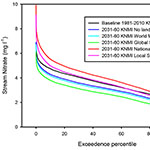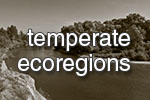Rivers in general - case studies
About the case studies
Climate variables such as temperature or evapotranspiration are very strong predictors of aquatic and terrestrial diversity and set the outer limit to the ranges of many species. Accordingly, a shift in climatic variables can lead to shifts in the ranges of species across latitudes and altitudes (Burgmer et al, 2007).
By using meta-analysis techniques and with the help of species distribution models (SDM) predictions can be made of large distributional shifts in species and communities across large geographic scales.
A selection of case studies are presented for each ecosystems type (lakes, rivers and wetlands) demonstrating large-scale changes in the distribution of species and communities already occurring or that are predicted to take place in the future.
For further reading
- Burgmer, T., Hillebrand, H., & Pfenninger, M. (2007). Effects of climate-driven temperature changes on the diversity of freshwater macroinvertebrates. Oecologia, 151(1), 93–103. doi:10.1007/s00442-006-0542-9
link to article - Logez, M., Bady, P., & Pont, D. (2012). Modelling the habitat requirement of riverine fish species at the European scale: sensitivity to temperature and precipitation and associated uncertainty. Ecology of Freshwater Fish, 21(2), 266–282. doi:10.1111/j.1600-0633.2011.00545.x
link to article
Selected case studies
Implications of climate and land use change for diffuse pollution in a transitional temperate catchment (REFRESH outcome)

Cited work:
Dunn, S.M.; Castellazzi, M.; Shahgedanova, M.; Jackson-Blake, L.; Brown, I.; Sample, J.; Helliwell, R.C. 2012. Modelling scenarios of land use and climate change on diffuse pollution from agricultural nitrate. Proceedings of the 11th BHS National Hydrology Symposium, University of Dundee, 9-11 July 2012.
Ecosystem type:
Rivers
Variable being affected:
Chemical (Nutrients)
Key message:
Changes in losses of diffuse pollutants can be expected as a result of both climate and land use changes in the future. For a temperate catchment in a transitional agricultural zone, the scale of the expected change in nitrate losses was found to lie in the range of +/- 0 to 23% depending on the actual climate and land use change.
Background:
 Figure 01
Figure 01Click to enlarge
Under the requirements of the EU Water Framework Directive, national regulatory authorities are required to implement river basin management plans aimed at achieving future improvements and preventing deterioration in the ecological status of water bodies. In addition to an understanding of the factors determining current water quality, this also requires a sound understanding of how systems will respond to future changes in climate and land use. A model application has been developed for a case study catchment in north east Scotland which lies in a transitional zone between the agricultural lowlands and montane uplands (Fig 1), to explore how future scenarios of climate and land use could be expected to impact on stream water quality.
Main results:
 Figure 02
Figure 02Click to enlarge
 Figure 03
Figure 03Click to enlarge
Four scenarios of future land use representing different future economic drivers (Fig 2) were explored for the catchment in conjunction with three different climate simulations for the 2050s period. The climate simulations differed in the direction of predicted change in concentrations with one indicating a wetter more dilute chemical signal, one remaining broadly neutral and one indicating a drier more concentrated chemical signal. The scale of change resulting from the climate simulations alone was of the order of +/- 0 to 10%. The set of land use scenarios, when combined with the climate simulations, also led to differing responses in terms of either increased or decreased pressure from diffuse pollution. The overall scale of changes was found to lie in the range of +/- 0 to 23% difference in stream nitrate concentrations (Fig 3). The high uncertainties inherent in the future scenarios are the over-riding factor in anticipating future pressures on water quality and the associated ecological status of water bodies.
Conclusions:
Emergent aquatic macrophyte distributions will expand due to climate change. Many emergent aquatic plant species have already expanded their distributions during the past decades, and this process will continue in the years 2051–80. Emergent aquatic macrophytes pose an increasing overgrowth risk for sensitive macrophyte species in boreal freshwater ecosystems, which should be acknowledged in management and conservation actions. We conclude that predictions based on GIS data can provide useful ‘first-filter’ estimates of changes in aquatic–terrestrial ecotones.
The processes and effects of droughts and summer floods in rivers and threats due to climate change on current adaptive strategies. (REFRESH outcome)

Cited work:
François K. Edwards, Roger Baker, Michael Dunbar and Cedric Laizé. REFRESH deliverable 2.14
Ecosystem type:
Rivers
Variable(s) being affected:
Abiotic (hydrology, water quality) and biotic (algae, macrophytes, invertebrates, fish)
Background:
Climate change scenarios generally predict a greater frequency and magnitude of seasonal, supraseasonal and aseasonal droughts and floods in Europe in coming decades, though the details can vary between scenarios. River ecosystems are vulnerable to changes in hydrological regime extremes, particularly when those are a-seasonal and supra-seasonal, and thus fall beyond what natural systems have adapted to cope with. To better predict the ecological impacts of droughts and floods caused by climate change, it is necessary to review the processes and effects of droughts and floods, as well as the management strategies that may be affected by these changes. Edwards and coauthors reviewed information on droughts and a-seasonal floods (summer floods) since 2000 with a principal focus on small lowland rivers. Using several recent (post 2000) reviews on these topics, they described abiotic and biotic effects of droughts and floods, providing recent European examples where possible.
Main results:
Climate change is expected to affect the hydrology of all European regions in some way. Negative impacts will include increased risk of inland flash floods, and more frequent coastal flooding. Mountainous areas will face glacier retreat and reduced snow cover. In Southern Europe, climate change is projected to worsen conditions (high temperatures and drought) in a region already vulnerable to water shortages. In Central and Eastern Europe, summer precipitation is projected to decrease, causing higher water stress. In Northern Europe, climate change is initially projected to bring mixed effects, including some benefits such as reduced demand for heating, but, as climate change continues, its negative impacts, including more frequent floods are likely to outweigh its benefits. The trend for warmer water temperature will alter fundamental ecological processes and are likely to change species distributions. The growth rates of plants and animals may be stimulated and lengths of lifecycle may change, permanently altering community structure and ecosystem trophic dynamics. Water quality may decrease as microbial activity and decomposition of organic matter increase, adding to reduced oxygen levels associated with higher temperatures. Aquatic species unable to migrate (regionally to cooler climes or within a river to the cooler headwaters) may face local extinctions. Conversely, there is a strong risk that non native invasive species, with broader temperature tolerances, may spread to new territories and establish themselves rapidly, applying further stress to native species.
Conclusions:
Both droughts and floods have the potential to affect river ecosystems profoundly, and all types of flora and fauna are likely to be impacted: algae, macrophytes, invertebrates and fish. Also terrestrial organisms associated with rivers will also be impacted, e.g. birds, mammals, amphibians. All river types are likely to be affected, but some important characteristics of rivers will determine how much they are affected by climate change, in particular morphology and the proportion of groundwater input, as these two factors provide most of the resilience to drought. In-stream habitat diversity, and in particular the presence of refugia such as pools, wetted areas and the hyporheic substrate, are essential for ecological recovery from drought. The same could be said for floods; in this case in stream refugia might include low-flow zones, large boulders, emergent macrophytes etc. Taxa adapted to poor water quality and habitat degradation are also better adapted to drought. From a biomonitoring perspective, ecological quality metrics for drought impacted systems are likely to be low. Though it is clear that these ecological effects will translate into impacts on ecosystem functioning and the delivery of ecosystem services, little consideration has so far been given to this subject area.
The effect of climate change on the distribution of fish in Europe
Cited work:
Logez, C. M., Belliard, J., Melcher, A., Pletterbauer, F., Schmutz, S., & Gorges, G. (2012). Deliverable D5. 1-3: BQEs sensitivity to global / climate change in European rivers: implications for reference conditions and pressure-impact-recovery chains.
Ecosystem type:
Rivers, Lakes
Variable being affected:
Biological (Fish)
Background:
Temperature and hydrology are the main environmental drivers of fish species distribution along river networks. The observed and projected changes in climatic conditions imply modifications of the environmental conditions and thus of the habitat suitable for fish species. In response to these changes, shifts of fish species distributions are expected. From the scope of conservation, it is very important to anticipate the effect of global change on species occurrences so as to evaluate the loss and/or gain of habitat that would be observed depending on the gas emission scenarios. Logez and Pont have assessed the possible impacts of climate change on 23 widespread European fish species. Potential current and future distributions of species were predicted (for the years 2020–2030 and 2050–2060) using the 23 models, and the predicted probabilities of species presence for the 4543 sampling sites were computed.
Main results:
Generally, the scenario for the 2020–2030 period predicts that all fish species, except Atlantic salmon, are will experience distribution shifts, occur in new locations and disappear from sites where they were present. Specifically, bleak, eel, barbel, nase, gudgeon, chub, dace, perch, ninespine stickleback, bitterling, roach and soufie are expected to experience an expansion of their distribution areas (more new occurrences than new absences). Stone loach, bullhead, northern pike, threespine stickleback, lamprey, burbot, minnow, Atlantic salmon, brown trout and grayling are expected to have a contraction of their distribution areas.
Conclusions:
The projections highlight that climate-change pose a major threat for species preferring cold- to cool-water temperatures, even for relatively eurythermal such as brown trout. On the other hand, species preferring warmer temperatures and with large thermal ranges will be less affected by climate change and may even be favoured by it. Climate change will also hasten the species turnover and modify the composition of the species assemblage. Indeed the stream sections with suitable environmental conditions will be greatly reduced for species such as Atlantic salmon and grayling, whereas bitterling and bleak will occur in many more reaches. For species with intermediate thermal preferences, the response patterns are more contrasted, with environmental conditions becoming either suitable or unsuitable. For these species, a shift in their distribution is expected, both at the watershed scale and over their distribution area.
Vulnerability assessment of European stoneflies to climate change
Cited work:
Tierno de Figueroa, J. M., López-Rodríguez, M. J., Lorenz, A., Graf, W., Schmidt-Kloiber, A., & Hering, D. (2009). Vulnerable taxa of European Plecoptera (Insecta) in the context of climate change. Biodiversity and Conservation, 19(5), 1269–1277. doi:10.1007/s10531-009-9753-9
Ecosystem type:
Streams, Rivers
Variable(s) being affected:
Biological (macroinvertebrate)
Background:
Among freshwater macroinvertebrates, stoneflies are the most intolerance of environmental alterations when used as bioindicators. Stoneflies nymphs are usually found in cold, well-oxygenated running waters and adults are aerial with low dispersal capacity, due to reduced flight ability. This makes stoneflies especially vulnerable to the impacts of climate change. Within the stoneflies, more vulnerable species will be those that favor cold and fast flowing water, living at higher altitudes and confined to the upper reaches of streams and rivers, mainly in the crenal zone. Due to restricted distribution or small populations, endemic species and subspecies (and mainly microendemic taxa) and rare taxa will be more threatened. Rare or restricted taxa with the above characteristics will be even more endangered. Of all the European species and subspecies, taxa found in ecoregions that will experience a greater increase in temperature and/or more severe drought episodes will be more affected by the new conditions.
Tierno de Figueroa et al (2009) conducted an extensive literature review, including the grey literature and unpublished expert opinions that provided specific information on taxa vulnerability to predicted future conditions. This data was used for evaluating the vulnerability of stonefly species from different European ecoregions that was based on future temperature and precipitation patterns.
Main results:
Altogether, 516 species and/or subspecies of European stoneflies were examined and categorized according to autoecological data. The analysis showed that at least 324 taxa (62.8%) can be included in one or more categories of vulnerability to climate change. Of these, 43 taxa would be included in three or more vulnerability categories, representing the most threatened taxa. The most threatened species and the main factors affecting their distribution are discussed in the paper. Endangered lowland (potamal) species, with populations that have decreased mainly as a consequence of habitat alteration, also could suffer from the effects of climate change. Thus, the total number of taxa at risk is particularly high. Not only are a great diversity of European stoneflies concentrated in the Alps, Pyrenees and Iberian Peninsula, but so are the most vulnerable taxa. These places are likely to be greatly affected by climate change according to climate models.
Conclusions:
In general, an impoverishment of European stonflies taxa will probably occur as a consequence of climate change, and only taxa with wide tolerance ranges will increase in abundance, resulting in lower overall faunal diversity.
Climate change and the future distributions of aquatic macrophytes across boreal catchments
Cited work:
Alahuhta, J., Heino, J., & Luoto, M. (2011). Climate change and the future distributions of aquatic macrophytes across boreal catchments. Journal of Biogeography, 38(2), 383–393. doi:10.1111/j.1365-2699.2010.02412.x
Ecosystem type:
General
Variable being affected:
Biological (primary producers)
Background:
Aquatic–terrestrial ecotones are vulnerable to climate change, and degradation of the emergent aquatic macrophyte zone would have severe ecological consequences for freshwater, wetland and terrestrial ecosystems. The aim of this study was to uncover future changes in boreal emergent aquatic macrophyte zones by modelling the occurrence and percentage cover of emergent aquatic vegetation under different climate scenarios in Finland by the 2050s. Data derived from different GIS sources were used to estimate future emergent aquatic macrophyte distributions in all catchments in Finland (848 in total). Generalized additive models (GAM) were used to explore the main environmental determinates (climate and geomorphology) of emergent aquatic macrophyte distributions, which were derived from the national subclass of CORINE land- cover classification. The accuracy of the distribution models (GAMs) was cross- validated, using percentage of explained deviance and the area under the curve derived from the receiver-operating characteristic plots.
Main results:
The results indicated that emergent aquatic macrophytes will expand their distributions northwards from the current catchments and percentage cover will increase in all of the catchments in all climate scenarios. Growing degree-days was the primary determinant affecting distributions of emergent aquatic macrophytes. Inclusion of geomorphological variables clearly improved model performance in both model exercises compared with pure climate variables.
Conclusions:
Emergent aquatic macrophyte distributions will expand due to climate change. Many emergent aquatic plant species have already expanded their distributions during the past decades, and this process will continue in the years 2051–80. Emergent aquatic macrophytes pose an increasing overgrowth risk for sensitive macrophyte species in boreal freshwater ecosystems, which should be acknowledged in management and conservation actions. We conclude that predictions based on GIS data can provide useful ‘first-filter’ estimates of changes in aquatic–terrestrial ecotones.












